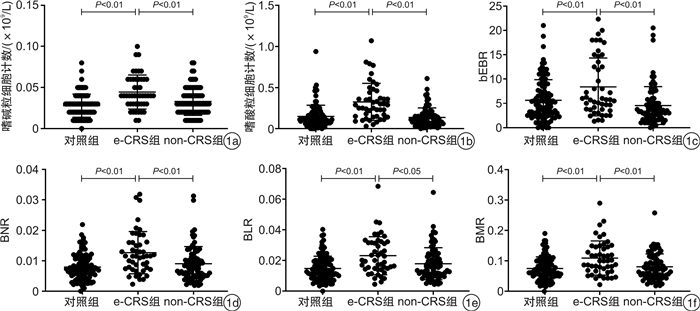Correlation between chronic sinusitis subtypes and basophil levels in peripheral blood
-
摘要: 目的 探讨外周血嗜碱粒细胞计数及相关比值与慢性鼻窦炎(CRS)的临床相关性。方法 回顾性分析2021年1月-2022年10月于苏州大学附属第一医院收治的126例CRS患者(CRS组)和103例健康体检者(对照组),根据组织学病理分为嗜酸性CRS患者(eCRS组)47例和非嗜酸性CRS患者(non-eCRS组)79例,比较3组外周血炎症细胞计数及嗜酸粒细胞/嗜碱粒细胞比值(eosinophils-to-basophils ratio,bEBR)、嗜碱粒细胞/中性粒细胞比值(basophils-to-neutrophils ratio,BNR)、嗜碱粒细胞/淋巴细胞比值(basophils-to-lymphocytes ratio,BLR)、嗜碱粒细胞/单核细胞比值(basophils-to-monocytes ratio,BMR)等之间的差异,并研究各项指标与Lund-Mackay评分的相关性,外周血中嗜碱粒细胞与其他炎症细胞的相关性。结果 对照组、eCRS组、non-eCRS组外周血嗜碱粒细胞计数分别为0.03±0.01、0.04±0.02、0.03±0.02,bEBR分别为5.64±4.22、8.38±5.95、4.55±3.90,BNR分别为0.01±0、0.01±0.01、0.01±0.01,BLR分别为0.01±0.01、0.02±0.01、0.02±0.01,BMR分别为0.08±0.04、0.11±0.06、0.08±0.04,3组间两两对比,eCRS组与对照组、non-eCRS组相比差异均有统计学意义(P < 0.01),non-eCRS组与对照组相比,差异均无统计学意义(P>0.05)。CRS患者嗜碱粒细胞计数(r=0.185 5,P < 0.05)、BLR(r=0.226 9,P < 0.05)、BMR(r=0.228 1,P < 0.01)均与Lund-Mackay评分呈正相关。此外,CRS患者嗜碱粒细胞与嗜酸粒细胞(r=0.479 2,P < 0.01)、淋巴细胞(r=0.259 4,P < 0.01)、单核细胞(r=0.256 4,P < 0.01)亦显著呈正相关性。结论 外周血嗜碱粒细胞计数、BLR、BMR在eCRS中显著升高,且与Lund-Mackay评分呈显著正相关性,有潜力开发成为eCRS的疾病生物标记物及新的治疗靶点。Abstract: Objective To explore the clinical correlation between peripheral blood basophil levels and chronic sinusitis (CRS) subtypes.Methods One hundred and twenty-six patients with CRS and 103 healthy cases from physical examination admitted to the First Affiliated Hospital of Soochow University from January 2021 to October 2022 were retrospectively analyzed. According to the histopathological classification, CRS patients were divided into eosinophilic chronic sinusitis (eCRS) group (47 cases) and non eosinophilic chronic sinusitis (non-eCRS) group (79 cases). The differences among the three groups in peripheral blood inflammation cell counts, eosinophils-to-basophils ratio(bEBR), basophils-to-neutrophils ratio(BNR), basophils-to-lymphocytes ratio(BLR), basophils-to-monocytes ratio(BMR) were compared, and study the correlation between each index and Lund-Mackay score, and the correlation between basophils in peripheral blood and other inflammatory cells.Results The counts of basophils in the peripheral blood of the healthy control group, eCRS group and non-eCRS group were 0.03±0.01, 0.04±0.02, 0.03±0.02, respectively, the eosinophils-to-basophils ratio(bEBR) were 5.64±4.22, 8.38±5.95, 4.55±3.90, the basophils-to-neutrophils ratio(BNR) were 0.01±0, 0.01±0.01, 0.01±0.01, and the basophils-to-lymphocytes ratio(BLR) were 0.01±0.01, 0.02±0.01, and 0.02±0.01, respectively, the basophils-to-monocytes ratio(BMR) were 0.08±0.04, 0.11±0.06, and 0.08 ±0.04 respectively. There was a statistically significant difference between eCRS group and healthy control group, non-eCRS group(P < 0.01), while there was no statistically significant difference between non-eCRS group and healthy control group(P>0.05). Basophil counts (r=0.185 5, P < 0.05), BLR(r=0.226 9, P < 0.05), BMR(r=0.228 1, P < 0.01) in patients with CRS were positively correlated with Lund Makey score. In addition, basophils were also positively correlated with eosinophils(r=0.479 2, P < 0.01), lymphocytes(r=0.259 4, P < 0.01), and monocytes(r=0.256 4, P < 0.01) in patients with CRS.Conclusion The peripheral blood basophil count, BLR and BMR were significantly increased in eCRS, and were significantly positively correlated with Lund -Makey score. It has the potential to develop into disease biomarkers and new therapeutic targets of eCRS.
-
Key words:
- chronic sinusitis /
- basophils /
- eosinophils /
- lymphocytes /
- monocyte
-

-
[1] Stevens WW, Peters AT, Tan BK, et al. Associations Between Inflammatory Endotypes and Clinical Presentations in Chronic Rhinosinusitis[J]. J Allergy Clin Immunol Pract, 2019, 7(8): 2812-2820. doi: 10.1016/j.jaip.2019.05.009
[2] Kim DK, Eun KM, Kim MK, et al. Comparison Between Signature Cytokines of Nasal Tissues in Subtypes of Chronic Rhinosinusitis[J]. Allergy Asthma Immunol Res, 2019, 11(2): 201-211. doi: 10.4168/aair.2019.11.2.201
[3] Klingler AI, Stevens WW, Tan BK, et al. Mechanisms and biomarkers of inflammatory endotypes in chronic rhinosinusitis without nasal polyps[J]. J Allergy Clin Immunol, 2021, 147(4): 1306-1317. doi: 10.1016/j.jaci.2020.11.037
[4] Stevens WW, Peters AT, Tan BK, et al. Associations Between Inflammatory Endotypes and Clinical Presentations in Chronic Rhinosinusitis[J]. J Allergy Clin Immunol Pract, 2019, 7(8): 2812-2820. doi: 10.1016/j.jaip.2019.05.009
[5] Kato A, Schleimer RP, Bleier BS. Mechanisms and pathogenesis of chronic rhinosinusitis[J]. J Allergy Clin Immunol, 2022, 149(5): 1491-1503. doi: 10.1016/j.jaci.2022.02.016
[6] Sharma M, Bayry J. Autoimmunity: Basophils in autoimmune and inflammatory diseases[J]. Nat Rev Rheumatol, 2015, 11(3): 129-131. doi: 10.1038/nrrheum.2014.199
[7] 张秩荻, 马芙蓉, 刘俊秀, 等. 鼻分泌物Ⅱ型炎症细胞因子在嗜酸粒细胞型CRS伴鼻息肉中的表达及其预测价值[J]. 临床耳鼻咽喉头颈外科杂志, 2022, 36(12): 934-939. https://lceh.whuhzzs.com/article/doi/10.13201/j.issn.2096-7993.2022.12.009
[8] 陈炜, 王璐, 谢斌, 等. B细胞活化因子在CRS伴鼻息肉的诊断及分型中的应用价值[J]. 临床耳鼻咽喉头颈外科杂志, 2021, 35(10): 886-891. https://lceh.whuhzzs.com/article/doi/10.13201/j.issn.2096-7993.2021.10.005
[9] 康成林, 刘朋, 刘悦, 等. 变应性鼻炎免疫发病机制中相关细胞的作用[J]. 中国现代医生, 2022, 60(35): 128-131, 152. https://cdmd.cnki.com.cn/Article/CDMD-11117-1021142657.htm
[10] 张志存, 李佩忠, 唐海燕, 等. 慢性鼻-鼻窦炎伴鼻息肉患者外周血和息肉组织中嗜酸粒细胞相关性分析[J]. 临床耳鼻咽喉头颈外科杂志, 2019, 33(1): 14-16, 22. https://www.cnki.com.cn/Article/CJFDTOTAL-LCEH201901004.htm
[11] Kagoya R, Kondo K, Baba S, et al. Correlation of basophil infiltration in nasal polyps with the severity of chronic rhinosinusitis[J]. Ann Allergy Asthma Immunol, 2015, 114(1): 30-35. doi: 10.1016/j.anai.2014.09.017
[12] Veloso-Teles R, Cerejeira R, Roque-Farinha R, et al. Systemic Immune Profile in Patients With CRSwNP[J]. Ear Nose Throat J, 2021, 100(5_suppl): 554S-561S. doi: 10.1177/0145561319893163
[13] Mahdavinia M, Carter RG, Ocampo CJ, et al. Basophils are elevated in nasal polyps of patients with chronic rhinosinusitis without aspirin sensitivity[J]. J Allergy Clin Immunol, 2014, 133: 1759-1763. doi: 10.1016/j.jaci.2013.12.1092
[14] Stevens WW, Staudacher AG, Hulse KE, et al. Studies of the role ofbasophilsinaspirin-exacerbated respiratory disease pathogenesis[J]. J Allergy Clin Immunol, 2021, 148(2): 439-449.
[15] Parrino D, Brescia G, Zanotti C, et al. Non-Eosinophilic Chronic Rhinosinusitis With Nasal Polyps: Eosinophil, Basophil, and Neutrophil Blood Counts Before and After Surgery[J]. Ann Otol Rhinol Laryngol, 2019, 128(3): 233-240.
[16] Brescia G, Barion U, Zanotti C, et al. The prognostic role of serum eosinophil and basophil levels in sinonasal polyposis[J]. Int Forum Allergy Rhinol, 2017, 7: 261-267.
[17] Brescia G, Sfriso P, Marioni G. Role of blood inflammatory cells in chronic rhinosinusitis with nasal polyps[J]. Acta Otolaryngol, 2019, 139(1): 48-51.
[18] Brescia G, Marioni G, Franchella S, et al. Can a panel of clinical, laboratory, and pathological variables pinpoint patients with sinonasal polyposis at higher risk of recurrence after surgery?[J]. Am J Otolaryngol, 2015, 36: 554-558.
-





 下载:
下载:

